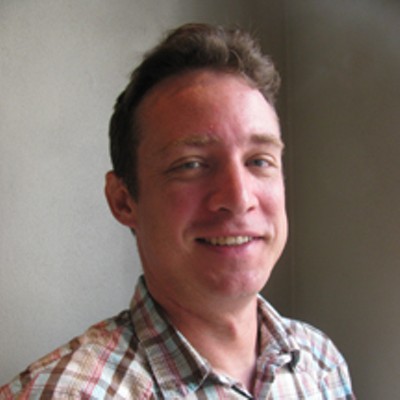"Anyway," says Guest, "they went their separate ways when it was established that she was pregnant, and she hasn't seen him since. He is aware of my existence, though. She came down here to have me -- and this is really sad -- but a month before I was born, her dad died of a massive heart attack. So one month before she's about to have this baby she's gonna have to give up, her dad blows it.
"And just as you might think, it was very difficult for her to let me go, and then she had to do it, and just...went back home. And she says that no day has passed since that she doesn't think about it. I guess if you were a mom, that's what would happen. Within a couple of years she had gotten married, she finished college in Michigan, and she taught school for a couple of years, and she's been a full-time mom ever since. She has three daughters. This whole thing has almost been like that damn TV show, Who's Your Daddy?"
And just like on the weeper of an Only Fox Would Dare Do This reality special, there's a happy ending. Guest is elated. "I'm 37 years old and just entering what is basically the second half of my life," he says. "So I'm sort of ecstatic about it basically. There's no problem here. This is what I've always wanted, and I'm in shock. Not car-accident shock, but psychological shock in a good way. I'm spinning a little bit, but mostly overflowing with happiness. This is the best thing that I thought would never happen."
Greenspan likes to say that FTDNA is like the Hair Club for Men -- not only is he the CEO, he's also a customer. A real estate developer and entrepreneur, Greenspan has been interested in genealogy since his preteen days. He recalls drawing up his first family tree at age 11 or 12. "I was just interested in it," he says. "I was the only one in the family who was interested in it. My parents didn't understand -- but it was great because it gave me an excuse to talk to my grandparents and great-aunts, and of course they loved that. They would say things like, 'Oh, he's such an interesting young boy.' "
Like many genealogists, Greenspan hit some dead ends. In the mid-'90s, he discovered another Greenspan living in Argentina who grew up ten miles from his grandfather in Ukraine and whose family was in the same business as his. He had a hunch that they were related, but there were no documents to back it up. He wanted to do a DNA test, but no company did DNA testing for genealogical purposes back then. "I searched everywhere, and I was talking to a genetics professor at the University of Arizona, and he said somebody should start a company doing something like this, because he got phone calls from genealogists all the time," he says. "And sure enough, it took me a while, but eventually I convinced him at the University of Arizona to do the testing, and the rest is history. We really are the first company in the world to offer this service."
The Arizona genetics professor is Michael Hammer, who made waves in the '90s by discovering the Cohanim gene in Jews. By tradition, Cohanim are Judaism's priestly caste, said to be descended from Moses's brother Aaron. Hammer conducted a study and proved that a statistically significant percentage of Jewish men who claimed to be Cohanim did in fact share a genetic signature. Today, Hammer's lab does FTDNA's tests on a for-profit basis, and Greenspan's Houston office runs the operations.
And the business is doing well. The first anthrogenealogy conference, held in Houston late last year, was a success. Greenspan was treated as a rock star by the mostly aging genealogists who attended. The future of this young hybrid science was a hot topic. Greenspan believes his company will do nothing less than help to revolutionize the whole concept of the family tree. "Think of it this way: Think of the anthropological side as the branches and the limbs of a tree. Think of the genealogical side as the leaves. Right now we're probably missing the twigs -- in other words, I can tell a man by looking at his leaves what branch of the tree and maybe even what limb of the tree, but I can't tell him what twig he is on. Yet at the same time I can look at the leaves and make a comparison of them and get an idea of who is related. I think in the next few years many of those branches are gonna get fleshed out in such a way that we'll be able to do the whole branch-limb-twig-leaf deal.




